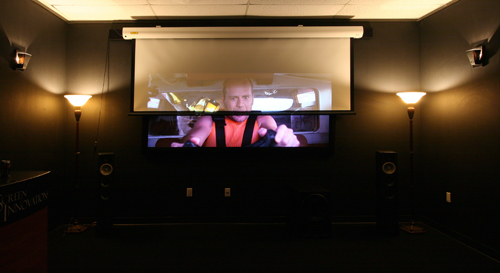Screen Innovations Black Diamond II Projection Screens

Like panthers or hamsters or bats, video projectors do the bulk of their business in the dark. But darkness makes most humans uncomfortable, which may be why front projection has never made it into the mainstream — in order to get a good picture, you have to turn most, and preferably all, of the lights off.
Screen Innovations has a different idea. This seven-year-old company makes a variety of screens, but it’s best known for the Black Diamond, a screen that reflects light shining directly at it from a projector and rejects light that comes at an angle (ambient room light from undraped windows or lamps, for example). Thanks to its directionality, it delivers a high-contrast picture even in a brightly lit environment. I tested a Black Diamond in last year’s screen roundup and generally liked what I saw, so when the company offered to fly me to Austin, Texas to test its new Black Diamond II material, I jumped at the chance.
According to company president Ryan Gustafson, Black Diamond II offers improved off-axis viewing — i.e., the image doesn’t darken dramatically when you move to the side. The new material is a laminate of seven different films and sheets, available with a rated gain of 0.8 or 1.4. A gain of 1.0 is equivalent to a matte white surface, similar to a typical piece of printer paper. The 0.8 gain material loses a bit of light and gives you a more “by the book” picture, while the 1.4 gain material focuses more of the light at you so you get a brighter image.
The company’s headquarters was practically bursting with projectors I could use for my test, but the excellent JVC DLA-HD550 was already set up so I stuck with that one. To fill the 2.35:1 106-inch-diagonal Black Diamonds, the projector was fitted with a Panamorph UV200 vertical compression lens.
I had the option to view the screens with the lights off; with four upward-firing sconce lights on; with two torchiere lights in the front of the room flanking the screen; or with the two overhead fluorescent lights in the drop ceiling. Screen Innovations also provided one of its 1.1 gain Gamma HD matte white screens to show how a typical screen would perform with the room lighting on.
BY THE EYES
Left alone in the room with a Pioneer Blu-ray Disc player and a few of my favorite demo discs, I experimented with different light levels and sources to gauge the efficacy of the Black Diamond IIs. With the lights off, the Gamma HD delivered a somewhat purer picture, although I was a little distracted by the light reflecting off the room’s white drop ceiling tiles. But with any light on at all, the Black Diamond II material delivered dramatically better contrast. The more light I added, the more the picture on the Gamma HD screen washed out. The Black Diamond IIs also reflected almost none of its light onto the surrounding walls and ceiling — something important in a room painted in light shades or saturated colors.
With the soft, upward-firing light from the sconces, the Gamma HD screen delivered a watchable picture, but the image lost much of its contrast and depth. The Black Diamond IIs, though, delivered the kind of picture I’m used to seeing from a front projector in an ideal environment, with great contrast and vivid color. The children’s classic Matilda looked much as it does on my home projection system; the super-saturated colors of the outfits worn by Harry and Zinnia Wormwood (Danny DeVito and Rhea Perlman) appeared every bit as garish as they’re supposed to.

With the torchiere lights on, the picture on the Gamma HD screen became barely watchable. It looked washed-out, with much of the color lost in the torchiere lights’ yellowish glare. With the Black Diamond IIs, the picture looked good; only the darkest parts, such as the black bars at the sides of 16:9-format programs, showed glare from the lights.













































